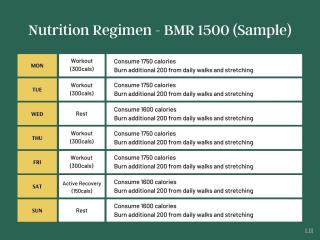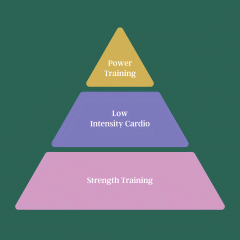Change begins with the hope of what’s possible in your life. Hope leads to a sense of expectancy Combine this with setting short-term goals, and the likelihood of being more happy and successful moves from possibility to reality.
Short-term goals, when created with well-formed criteria, offer incremental steps towards successfully achieving your bigger goals.
In this step-by-step guide, you’ll discover the secret to creating short-term goals that will set you up for success and help you sail past challenges of staying motivated easily.
What Is a Short-Term Goal?
Short-term goals are ‘short’, meaning the time frame can be as short as 10 minutes, a day, or as long as a week or a few months. Well-formed short-term goals begin with the end in mind.
Quick tip:
Write down the specific result you want to achieve and the date when it should happen. Then, work backward from this date, describing what you’ll notice yourself doing (and achieving) until you take the first step.
A short-term goal is the smallest step you need for you to reach a bigger goal centered around achieving something you passionately desire.
‘Passionate desire‘ is the key.
As Tony Robbins says,
People are not lazy. They simply have impotent goals – that is, goals that do not inspire them.
Having passion when setting goals means getting your mind and body activated to fuel your energy and focus. Each time you achieve a short-term goal, your body celebrates by producing and releasing chemicals such as dopamine, serotonin oxytocin, and endorphins (feel-good neurotransmitters).
Ian Robertson, a cognitive neuroscientist and author of The Winner Effect: The Neuroscience of Success and Failure, says,
Success and failure shape us more powerfully than genetics and drugs.
The regular release of the body’s natural chemicals supports brain change at a neural level, building your confidence, and renewing your goal-oriented focus.
The Benefits of Setting Short-Term Goals
Regardless of the area in your life where you set your short-term goals, it will have a ripple effect across all your life domains.
Improve your career prospects and your sense of identity also shifts. Improve your body shape through managing food intake and your energy improves in a way that’s noticeable at work and home. Improve your mindset and your attitude changes around how you engage with others. Improve your health and your desire for self-improvement lifts.6 Steps to Success With Short-Term Goals
Setting short-term goals will lead you closer to a happier and more successful life, but can you achieve that?
Take the following steps and you will start achieving your dreams:
Step 1: Know Your Best Hopes
Try this process yourself by thinking of an area in your life that you’d like to improve.
For example:
What are your best hopes for your finances? What are your best hopes for your relationship? What are your best hopes for your career? What are your best hopes for your health?This process involves ‘chunking up’ your ideas to imagine the results more clearly. In this process, you try to achieve not only the goal and the outcome it gives you but also the changes in your behavior and mindset as a result of achieving your goal.
Step 2: Notice What’s Different
The next question to ask yourself is: “What would you notice that was different from the way you usually did things?”
‘Noticing’ helps you build a vision of what could be possible. The richer the description you can build around the tiny details, the more ‘real’ your preferred future becomes.
Step 3: Ask: ‘What Else?’
Most of us know there’s a hidden reason or a long-buried hope beneath why we want something.
Often, our ego gets a little defensive about it and protective of it. But if we dig and resurface the truth, then weight can be lifted, allowing you the freedom to move forward.
Step 4: Ask: ‘Who Will Notice the Difference?’
Relationships with family, friends, colleagues, and your partner are important. Seeing the change they’ll notice helps put another perspective on the differences they see in you.
Imagine what they will notice about you that would let them know something changed about you as a result of achieving this goal.
Step 5: Imagine a Miracle Happened Tonight
Imagine that if you went to bed tonight and a miracle happened; and you were the very best version of yourself and that you had achieved your best hopes.
When you woke up tomorrow morning after the miracle happened, what would you notice that would tell you you’ve achieved the change you’re seeking?
Step 6: Describe Your Day as If the Miracle Had Happened
Go through your day, moment by moment. Begin with what time you would wake up and then describe the differences you would notice in every tiny action you do.
Notice in detail what’s different about this day – a day when you are at your very best because you’re living your best hopes.
How to Track Your Short Term Goals Success
When you set a short-term goal, establish a measurement system to track your progress:
1. Create a Running Tally
One of the best devices to keep your short-term goal setting on track is to keep a running record or tally of the number of days in a row that you’ve sustained your goal.
For example, if improving your health is important to you and you plan to reduce your weight by 5 kilos by not eating any foods containing sugar, then set up a simple chart and track how many days in a row you can do this. Aim for 5 days, then 10, then 20 days in a row. If you have a small diversion and eat sugar one day, simply start again.
Once you feel confident that you can continue with this step, add another such as taking 5,000 steps per day. Again, set up a simple tally chart either in your diary or somewhere visible and enjoy marking up one more day that you’ve achieved your short-term goal. It won’t be long before your goal of losing 5 kilos is met.
2. Keep a Journal
Maintaining a journal will help you focus on identifying the things that are different because you’ve set a well-formed short-term goal.
Aim to complete the journal at the end of each day and recall in detail the things that you’re noticing. This helps keep you connected with your desired outcome and the transformation you’re experiencing in both your behavior and mindset.
Take a look at this guide if you’re starting out journaling: Writing Journal for a Better and More Productive Self (The How-To Guide).
3. Share Your Progress With a Trusted Friend or Coach
By voicing the change and expressing how far you’re noticing yourself move towards your goal, you’re reinforcing the power of change you’re experiencing.
And you’ll be activating the feel-good neurotransmitters that are so important for bringing your confidence, motivation, and positive changes to your brain to succeed.
Here’re more reasons why you should get yourself a life coach: 7 Reasons Why You Should Find a Life Coach to Reach Your Full Potential.
4. Visualize Your Progress
Before you go to sleep in the evening, visualize your tomorrow. See yourself continuing to do the things that support your change.
Walk yourself through the tiny details that add up to the changes you want to see yourself doing, including the time you’ll wake up. In the morning, re-activate the visualization and then ‘step into’ your day.
Short-Term Goal Example: A Career Short-Term Goal
How to advance your career with short-term goals? Specifically, you will need short-term goals to help with your career. This is also how many people want to utilize short-term goals.
Start by Planning Your Career Visually
Walt Disney was sacked for lacking imagination. Oprah Winfrey was told she’d never make it on television. Careers are destroyed by naysayers intent on keeping you small. The successful person designs a career goal and then creates incremental steps to ‘ladder up’ with short-term goals.
Justin Dry from VinoMofo, a successful Australian wine distribution company, always begins his goal-setting process with visual planning. He says,
I need to see it all in front of me like a puzzle I’m putting together. It kind of looks like the workings of a madman with lots of weird and wonderful shapes and lines connecting the words.
Whether you use masses of post-it notes that cover a wall, large sheets of paper to spread your ideas on or a journal to map your path – messy planning gets your ideas out of your head so you see different possibilities and pathways available to you.
Begin this process by asking, “What are my best hopes for my career?”
Write them down and place them somewhere you’ll notice them every day.
Make You Think Like a Start-Up Entrepreneur
While successful career planning starts with a messy and random process to let those ‘idea gems’ – the embryos of well-formed short-term goals rise, the next step is taking these nuggets and using them to set your direction.
Think of yourself (and your career) as if you’re the CEO of your successful start-up – one with a clear vision of what you want and how you’ll get it. Rather than waiting for a boss to give you goals, be proactive, and set your own.
Karen Lawson, CEO of Slingshot says,
Set a vision, and be focused on the intent of these goals. Create actions which not only build on those of yesterday but also improve what you do tomorrow. Your pathways will need to be flexible, challenged, and accountable.
Begin by listing the bigger steps needed to achieve your goal. Then chunk these down into smaller steps with specific actions needed to achieve them. These action steps are the workhorses of your short-term goals.
Create a specific time frame to complete them and maintain accountability – as if you’re reporting to your ‘higher up’.
Begin this process by asking yourself: “What difference will I notice when I take these steps?” Then ask: “What difference will my boss/es notice when I take these steps?”
Establish ‘Triggers’ for Your Daily Habits
Twyla Tharp (born 1941) legendary dancer and choreographer, maintains an exacting routine designed to trick her mind into a daily exercise habit.
I begin each day of my life with a ritual; I wake up at 5:30 A.M., put on my workout clothes, my leg warmers, my sweatshirts, and my hat. I walk outside my Manhattan home, hail a taxi, and tell the driver to take me to the Pumping Iron gym at 91st street and First Avenue, where I workout for two hours. The ritual is not the stretching and weight training I put my body through each morning at the gym; the ritual is the cab. The moment I tell the driver where to go I have completed the ritual.
It’s a simple act, but doing it the same way each morning habitualizes it — makes it repeatable, easy to do. It reduces the chance that I would skip it or do it differently. It is one more item in my arsenal of routines, and one less thing to think about.
To do this list, create a trigger point – the smallest step you’ll do that will catapult you into taking action as Twyla Tharp did. What will be your ritual of ‘getting in the cab’?
Get You to Talk About the Future
Melanie Perkins CEO of Canva, a thriving design and publishing solution, is known for ‘frequently talking about the future’.
Orienting your thoughts towards a future-focus reinforces how important your vision and goals are to you. Ralph Waldo Emerson famously said, “You are what you think.”
Make it a habit to read your goals daily. Think about what you’ll notice that will be different in your life when you achieve them. Express your goals to someone important in your life. Whisper them to yourself throughout your day.Future-focused conversations (both with yourself and others) establish a pattern of expectancy, which continue fueling not only your desire but also the expectation of achieving it.
Manage Mental Resistance
When you begin with ‘hope’, you activate a sense of ‘expectancy’. A belief that what you want is not only possible, it’s within reach. Hope and expectancy are two powerful motivators in propelling you forward to a successful life.
When you’re ‘moving forward‘ with hope, you’re orienting yourself towards your desired future. When ‘moving away from‘ something you perceive as painful you’re activating ‘fear’, which can also be a strong motivator helping you avoid pain; for example, losing your job if your quarterly performance scores don’t improve.
Sarah, a manager at a busy merchandising company saw her doctor because she was feeling tired. After a thorough examination, the doctor advised Sarah to lose 15 kilos as this was contributing to her tiredness. The news felt overwhelming as Sarah worked long hours and rarely found time to shop for fresh food, so she relied on fast food to keep her going.
For Sarah, the doctor activated her fear by describing what could happen (heart attack and/or diabetes) if she didn’t manage her weight by shedding 15 kilos.
While ‘moving away from’ motivation can be successful, a way of amplifying positive motivators that will see Sarah begin ‘moving towards’ her goal is by talking about what outcomes Sarah would notice by losing 15 kilos.
For example, managing her weight may see Sarah being more efficient at work, getting out more socially, or feeling more able to manage work pressures and deadlines.
To do this with your own goal setting, think about what’s important to you about achieving your goals. Write down your answers. Ask: “What will you notice that will be different in your life when these changes happen?”
Summing It Up
Change is possible. Short-term goals that build upon each other are the stepping stones to achieving your best hopes.
Using your creative imagination by noticing the small differences occurring daily offers a positive way to create practical change in an easy and doable way.
Above all, make sure your goal is powered by ‘passionate desire’ so you achieve your desired outcomes.
More Tips About Goals Setting
Featured photo credit: JESHOOTS.COM via unsplash.com





























































